Swedish Baptists of Council Bluffs
Nearly midway between Omaha and Des Moines, and an hour north of the Halland settlement, our home in Walnut, Iowa, seemed to be in a Swedish blackout zone. Our earlier whimsical title "letters and papers from Iowa" was meant to indicate someone working out of his normal element (as did Bonhoeffer while in prison). That changed early this year thanks to Darlene Vergamini, a member of the Walnut Genealogy Club and resident of Council Bluffs. Both that city and Walnut are in Pottawattamie county but on opposite ends.
Both Augustana and Baptist sources had indicated the presence of churches in Council Bluffs quite early, but two of our Baptist sources described their work as "abandoned". We had seen a picture somewhere of the modest frame church, but little hope of determining its location. The Augustana sources in Iowa did not speak of a church there. Was the source too early, or did the Council Bluffs church belong to the closer Nebraska conference? If so, the Nebraska Augustana historians we know of also omitted it.
Then our fortunes changed when we were introduced to Darlene and mentioned in an offhand way that we were interested in stories of Swedish churches in Council Bluffs. Not only was she aware of them, but she soon sent us copies of clippings and reports of their stories and even two color pictures of one of the survivors! Thanks Darlene! Now we have the basis for a story and a fervent plan to visit the sites just as soon as spring arrives.

The First Swedish Baptist church in Council Bluffs
The article "Swedes and their Manner of Living in the Bluffs" cites John Levin as the oldest living Swede in the Bluffs. He came in 1868,and his son Frank was a cigar maker and coin collector in business at 11 Pearl street since 1877. He was also a Baptist. "Santiago" and "Turnpike" cigars later sold a million a year. Andrew Martin came a year later, was also a Baptist and a tailor for the well-known Beno's department store. The pair are listed in 1906 as trustees of the Swedish Baptist Church. By that date that group had existed somewhat more than fifteen years. For the record, other Swedish businessmen in the Bluffs were the Swanson Brothers, music dealers; Otto Applequist, grocer at 1017 W. Broadway; Simon Johnson, tailor at 544 W. Broadway; Ole Hakenson, grocer at 1019 W. Broadway; O. Ewall, grocer at 533 W. Broadway; and P.A. Johnson, shoe store owner at 114 W. Broadway.
As had been the case in Omaha, the initial entity was "Scandinavian Baptist", including Danes who by their majority had influenced the services to be in Danish. "this combined organization was effected in 1874 and Rev. John Heesel was the first pastor." This church was located on Mynster Street, aptly since Mynster is identified as one of the first Danes in the area. The language issue is given as the reason for the growing number of Swedes determining to sail forth on their own in 1893. Helpful American Baptists joined their welcoming committee as did pastors from Omaha, Kiron and Arthur, Iowa. The Omaha pastor was J. Johnson who served there from 1891 to 93. A Värmlander who had attended the seminary in Stromsburg, we are interested to trace his ministerial career to other such familiar churches as Cokato,MN, Princeton IL, and Boring, Oregon...each a Swedish community with Covenant as well as Baptist congregations.
A pastor of the Scandinavian congregation, H.H. Reichenbach and members W.K. Peterson and P. Mortenson also were part of the committee which is represented in this article as having an amicable parting of the ways. Ahlstrom's history refers to this as the "recognition Council"; probably the official agent of that form of "congregational polity" which holds each church as independent and has no bishop or overarching structure. The title of the new congregation was "First Swedish Regular Baptist Church." That title may have been a harbinger of things to come. Later reports have them joining with the American Baptist denomination...we have not seen the title "Regular" in Swedish Baptist congregations before. Ahlstrom probably typifies the Swedish Baptist historians who disapprove of this merging with American Baptists, hence he relegates them to his section on "Abandoned works." Apparently all the Kansas Swedish Baptist churches also merged with the American Baptists quite early, and the Bristow and Weston churches in Nebraska come to mind as well as having chosen this path. From the Omaha history we note that when the first Omaha congregation made its own earlier venture from "Scandinavian" to an exclusively Swedish work in 1880, A. Norene from the Bluffs was the secretary of their charter meeting.
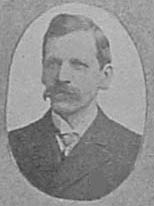
A. Norene: he helped form the Omaha church
The new congregation met at 2 Pearl St. in rented facilities. A "recent graduate" of the Swedish Baptist seminary in Morgan Park, Sandel by name, came to serve as pastor. From the seminary history we can indentify this as Victor Sandell, who went on to serve churches exclusively in the east coast area. He was actually a student pastor since he did not graduate till 1895, but it was standard practice to serve in smaller or newer parishes as part of the training in those days, as indeed it is today. (There was another Sandell, Erik, who would have traveled through Council Bluffs en route to the Central Bible Seminary during its brief existence in Stromsburg where he succeeded Edgren in 1886-88. But in '93 he was Dean of the seminary back in Chicago. The Sandells were from different provinces in Sweden, probably not related. Another article reports the first pastor as Rev. C. Sundahl, but this probably a spelling problem.)
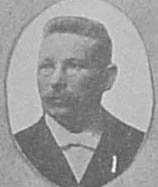
Victor Sandell, first pastor
Ahlstrom has a slightly different angle on the separation from the Danes; interestingly he has gotten his information from the Danish rather than Swedish church historian, and the Danish observer intimated the separation was "not a wise move". Ahlstrom goes on to say; "In the days when the writer was familiar with the activities of the church the Swedish hymn book was used more that the Danish, although most of the people were Danes." (p. 281) So, perhaps the Danish liturgy rankled the Swedes and the Swedish hymns rankled the Danes. Alhstrom identifies the first pastor as Victor Sandell, but mentions the leading laymen as A. Noren (Norene, above) and Gust Landstrom. Why he does not mention Levin and Martin we do not know.

Swedish Baptists of Council Bluffs
Beginning with sixteen members, the congregation grew to fifty and celebrated its twenty-fifth anniversary under the pastorate of J.P. Forsander. Forsander was born to members of Second Swedish Baptist Church of Chicago, where he was also ordained after graduating from the seminary in that city. He had served in Meriden, Iowa, and as regional evangelist before coming to the Bluffs. He later served at Centerville, South Dakota; Holdrege, Nebraska; and as a chaplain in the U.S. Navy.
Concluding his story of the Council Bluffs Swedish Baptists, Ahlstrom says; "On March 5, 1919, the organisation disbanded and turned the property over to the State Conference. The members joined the first American Baptist church."
Here the historian will encounter a major problem.
In a 1906 news clipping from Darlene Vergamini we read: "For a long time the First Swedish Baptist organization has felt the need of a new building. At the corner of Avenue "D" and Williams street stands a plain, one story structure which has been in use for some years. The poor location has been a decided handicap to the growth of the church, only about sixty members being enrolled at present... Rev. G.D. Forsell, who has been in charge of the local pastorate for the last few years, will continue in the capacity on the completion of the new building" The lot had been purchased on the corner of Sixth Ave. and Ninth St. Ahlstrom had described the "plain, one story structure" as a "fine little chapel"; his picture so indicates. He speaks of no building plans though writing in 1933.
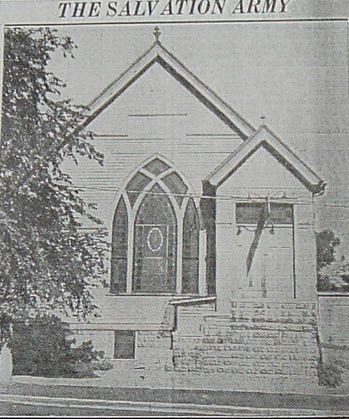
The Salvation Army is here in 1936!
While the reader ponders this discrepancy, let us switch topics to...the Salvation Army! This abrupt change comes about because of another of Darlene's clippings. It shows our "fine little chapel" in the hands of the Council Bluffs Salvation Army! From our sections on Omaha and Red Oak, we know that group often came into possession of churches which others had outgrown. Here we have another example, though this group was not one of the Swedish corps. This 1936 article tells of the Salvation Army's early history in the Bluffs; "In 1927 the (S.A.) took over the Swedish Baptist conference church structure at 28 North Seventh street." as the picture indicates. Both it, and a later Presbyterian building obtained in 1934 are described as used for worship.
First we have some physical issues to point out. Though the Salvation Army picture is clearly the same structure as the Baptist one from Ahlstrom's book, it has now acquired a basement. It is raised considerably, and this is commonly seen. The address, though very close to the one originally stated, has also changed. (Williams at 7th, or 331 Williams, to 28 North 7th)
Now more from the article outlining building plans: "...First Swedish Baptist, yesterday completed the preliminary arrangements for a new $4,000 church to be erected and completed for occupancy during the coming summer. (1906) The price paid for the site was $1,100, the deal being transacted by Charles E. Ring, Andrew Martin and Frank Levin Sr., trustees of the church." Pastor Forsell had studied in Chicago, but returned to Sweden to additional seminary work there and served two Baptist congregations there as well before returning to the U.S. and pastoring the Burlington, Iowa, church. When he came to Council Bluffs, we read that "The Baptist Swedish Society has been without a resident pastor for some time". From the Bluffs, which he left in 1908, he went to the venerable Village Creek, Iowa, congregation till 1911. This is his last listed post. His arrival in Council Bluffs was marked by a reception in the Changstrom home on Stahl Ave. "A large number of members and friends of the church were present and the evening was pleasantly spent in speechmaking and singing. Refreshments were served. Rev. Forsell comes to the local church very highly recomended."
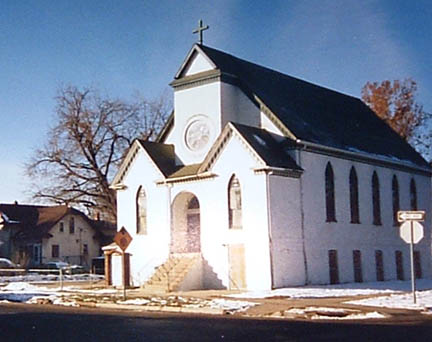
More to follow on this beautiful old church
***
These are the facts we have in hand. Because the medium we enjoy can be easily changed and corrected, we engage freely now in speculation. The article of 1906 does not hint at a change in the constitution of the Swedish Baptist congregation. It does not even mention "Regular" Baptists. But it does mention two names conspicuously absent from the Ahlstrom account: Levin and Martin. (Though the Martins are pictured) Did they favor alliance with the Americans? Or was there a problem with disposal of the old church? There may be a clue in one word from the Salvation Army article: it reports that they, in 1927, took over the S. Bapt. "conference" church structure. They did not receive it from the congregation itself. This may be because the constitutions of churches generally specify that if a congregation changes its denominational alignment, the building reverts to the denomination that sponsored (and probably helped pay for) its organization. But as we noted above, Baptists are supposed to be independant and without conference authorities. Where did this "conference" come from? It had been formed in Des Moines in 1883 in order to sponsor a state missionary. While Ahlstrom's story details a long list of missionaries sent out through the years, there is no word as to who the officials of this organization were. Possibly none wanted to be identified as a pseudo-bishop type, least of all Ahstrom himself who would have been a very likely chairman of the group. We are perhaps too alert to the hint of conflicts in these early church stories, but such situations that are in no doubt at all as to factuality are numerous, unfortunately. Since the withdrawal from the Swedish Baptist Conference took place in 1919 and the Salvation Army acquired the "old" building in 1927, we are looking at a delay of the kind associated with legal proceedings. But, for now, all that is speculation.
new light after visit:
Later we drove by the 6th ave. and 9th st. address where high hopes for a new church were fixed in the clipping. The pictured church was not there. It was rather on north 7th at Mills! What now? Time to back up and rethink. (a.) the planned church never came off? (b.) it was rather built near the old location? A look at the Lutheran clippings revealed: the 7th and Mills address was instead the site of the Augustana Lutheran church! The picture is not of a Baptist, but an Augustana Lutheran church, forerunner to Emmanuel on north Broadway. Now we were making progress, but what became of the building plans of the Baptists?? We excuse ourselves the error since 7th and Mills was so near the Baptist's earlier site and across from the Children's Square originated by the Baptists. Whether Baptist or Lutheran, we may be sure that this was the heart of Swede town! Two other facts have emerged. The Baptist children's home now owns the old Lutheran building, and would like to make it their chapel. Pardon our confusion! On the site of the Baptist/Salvation Army structure now stands a modern Salvation Army facility.
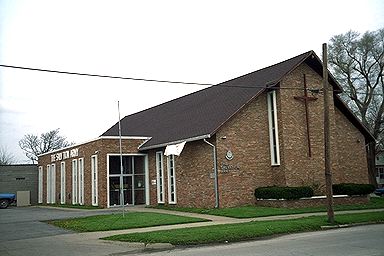
The Salvation Army today, on the Baptist site!
Adjacent to the Salvation Army/Swedish Baptist site there was a small monument company with a Swedish-sounding name...Bloom. We asked the secretary if there was a Swedish connection, but she reported the current managers' names and they sounded decidedly Irish. A look back at the Omaha Swedish Cultural Society books showed otherwise. Bloom senior settled in the Red Oak area and began carving headstones for his fellow immigrants. He moved this budding business to Council Bluffs at about the turn of the century. Bloom Inc. became one of the premier monument companies in Omaha and remained in the family for many years.

J.F. Bloom monument company, likely its original site
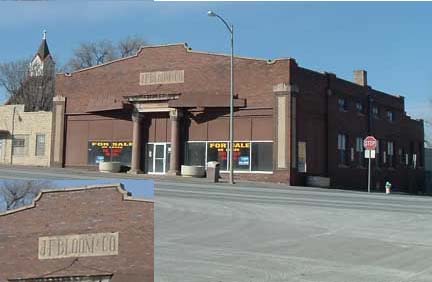
J.F. Bloom building in Omaha's Swedetown near Ford plant
* * *
Swedish Lutherans in Council Bluffs
"The Swedish Lutheran church was organized November 20, 1890, with twelve charter members. Rev. C.R. Elving of Omaha serving as the first pastor." Elving is associated with the Salem congregation in South Omaha which he founded in connection with his role as city missionary for the Augustana Synod's Nebraska Conference. The Nebraska historian reports that Elving and his family were quartered in an apartment addition to Salem for 25 years! He was known to be skilled in real estate transactions as well as ministerial functions, a combination which raised the eyebrows of some of his peers. "Emmanuel Lutheran Church was organized in 1890 at the German Lutheran Church on Seventh Avenue." We are now becoming more familiar with the Swedish area of the Bluffs, and fortunate that the recent highway improvements to Kanesville Boulevard narrowly spared some of the surviving structures. (when crossing the railroad viaduct eastbound, turn left just beyond the overpass to reach the area)

The German Lutheran church where Emmanuel
was organized in 1890 survives today!
We have another reference to the above church as "Our Savior's Scandanavian Lutheran Church", probably Danish, which was later located at 7th St. and 7th Ave. further south. Had they acquired it from the German congregation?
"The congregation (Emmanuel) and interest in the new church grew with such rapidity that in the early part of the following year it was decided to purchase 100 (sic) square feet of ground at the corner of 7th and Mills Streets, where a handsome brick church, 32 x 56 feet in size, and a parsonage was erected the succeeding fall." Perhaps the expertise of Pastor Elving is evident in these endeavors.

Emanuel today: all these buildings are within a few blocks
"The cornerstone of the Swedish Lutheran church was laid in September of 1893. The first services were held in the basement of the church. The first services were held in August of 1895. The church was dedicated in 1897. At one time (this being written some time after the 1962 move north) there was a parsonage next door to the church." At some point, a new parsonage was built on Oakland which may be the very house now occupying that address.

612 Oakland today; is it the parsonage?
Following the work of C.R. Elving, the following ministers served Emmanuel: C.G. Widen, S.G. Larson (see Saunders County), A.A. Magneson, J.E. Rydbach and B.N. Glim. A.A. Magnuson had been pastor of the Princeton, IL, Mission church which the writer served as intern in the sixties. He was a member of the 1884 charter meeting of the Covenant church but later associated himself with the Augustana Lutheran denomination. Little doubt he is the pastor mentioned at Emmanuel. Members of Emmanuel included O. Applequist, C. Olson, O. Swanson, B.A. Olson, C.F. Nelson, P. Nelson, O. Falk, A. Bloom and V. Gunnison. In 1906 and probably other years as well, a six week "Swedish school" was held in the church "to drill the young people in their native tongue." That would be the native tongue of the adults, not the children!
Subsequent to the congregation moving to North Broadway, the original church was given to the "Children's Square" institution located just across the street north. That ministry of the Bluffs Baptists now envisions renovating the venerable structure into a chapel. What a fitting new chapter that would be!

Emanuel Lutheran Church ELCA today
In the following summer we had a delightful visit to attend a Sunday morning service at the only Swedish heritage church in our county, Emmanuel Lutheran church at 2444 North Broadway, Council Bluffs. Members were friendly and eager to share about their heritage. Among the images we were able to carry from this meeting was the impressive window from the old church preseved prominently in the narthex.

The past preserved. Also shown is the baptismal font.
The cornerstone from the old church was also moved to the new location. A word about the variant spellings "Immanuel", "Emmanuel" etc. A member commented on their own distinctive variant "Emanuel" as it appears on the cornerstone. In more recent times, a second "m" is often added.

Just one letter "M"
Another member ventured into a storage area to retrieve one of the centennial plates from that event held in 1990. What a surprise when they made it a gift to us! Shown are the old church and the new one before and after another addition was made.

A gift from the generous Emanuel people!
The centennial history accounts of the church did not mention Rev. Elving of Omaha. They did mention a suggestive note concerning a large influx of members in the twenties "not of Lutheran background." Were these Swedish Baptists who yearned for Swedish services when their neighboring church joined with the English-speaking Baptists at about this time?